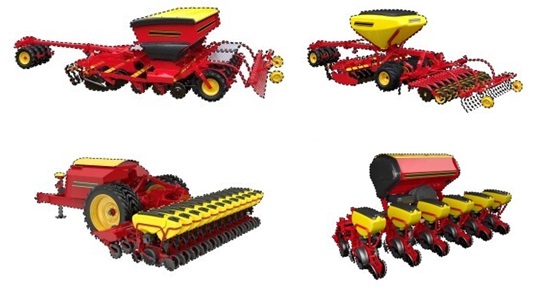31.10.2024
Intellectual property (IP) rights are important for businesses and individual entrepreneurs across the agri-tech sector. While most innovative companies will be familiar with the protection available through the patent system, other IP rights can also be useful. These include design rights, trade marks and copyright.
Thank you
Design rights are available in most countries, but there are differences in the protection available and the registration requirements that can make the subject confusing and also lead to pitfalls for the unwary. Designs are sometimes known as industrial designs and in some countries, such as the US, they are called design patents.
In the UK, registered designs protect the appearance, shape or decoration of a product. They are relatively easy and inexpensive to obtain, as there is no substantive examination of applications ahead of registration (the official fee ranges from £50 for one design to £150 for up to 50). Once granted, a registered design can last up to 25 years if renewal fees are paid at 5-yearly intervals.
One of the advantages of design rights is that they can be used to protect everything from a logo to a large vehicle. They are particularly popular for retail goods including furniture, electronics, jewellery, industrial and medical equipment, and transport but are also used by companies in the agri-tech space.
A quick search on the Designview database shows more than 400 registered designs in the UK for “agricultural machines” and more than 100 for “agricultural machinery”. These range from simple tools to complex equipment. Examples of registered designs include feeding devices, pumps, mowing machines, balers, tractors and aerators.
Like patents, designs must be new at the time of filing, though in the UK, and many other jurisdictions, designs have a grace period of one year for any disclosure made by the designer in the UK. Design must also have individual character compared to other designs on the market. Designs whose appearance is dictated solely by function are excluded from protection.
The validity of a registered design can be challenged on the basis that these criteria were not met and if the challenge is successful the design right will be revoked. It is therefore important to do a thorough search and prepare your application carefully before filing.
In particular, careful thought should be given to the indication of the product and classification (see below) and to the illustrations depicting it. In the UK, online applicants can include up to 12 illustrations, which can be line drawings (recommended), CAD images or photographs. They should be clear and complete and entirely consistent and should clearly indicate if any parts of the product are not claimed – either by marking the images or adding explanatory text.
Design protection in EU countries is very similar to that in the UK, except that pan-EU protection is available through the registered Community design right, administered by the EU Intellectual Property Office.
Elsewhere in the world, however, there are some important differences. Notably, countries including the United States, Japan and Korea carry out substantive examination of design applications. This means that examination takes longer, costs are higher and designs can be refused before grant. The period of protection also varies. It is therefore recommended to work closely with an IP specialist who can ensure that maximum coverage is obtained and pitfalls are avoided bearing in mind the requirements in each particular case.
Fortunately, there are some moves towards harmonisation of procedures which help to limit costs and smooth processes for applicants. The Hague System, administered by the World Intellectual Property Organization, facilitates the registration and renewal of designs and currently covers 97 countries, including the UK (which joined in 2018).
In addition, many IP offices, including the UK and EU, use the Locarno Classification, which is a thorough categorisation of goods into classes and sub-classes. For example, Class 12-09 is “Tractors” and Class 15-03 is “Agricultural and forestry machinery”.
In November 2024, Saudi Arabia is hosting a Diplomatic Conference to Conclude and Adopt a Design Law Treaty. The proposed treaty aims to streamline the global design system, making it easier for applicants to file across borders.
In some countries, designs can also be protected as unregistered designs and under copyright law at no cost, and with no official registration process. However, the term of protection for unregistered designs is shorter and infringement is limited to direct copying – it is also likely to be harder to prove in court. Unregistered designs are therefore most commonly relied on in industries where counterfeiting is more common and can be more easily demonstrated, such as the fashion sector.
Trade marks are another IP right that may be relevant for agri-tech innovation. Although most trade marks are for words and logos, they are also available for other characteristics that are distinctive of a particular product or service, including the shape of a product or its packaging, a position or pattern, a single colour or colour combination, a sound and a hologram.
An interesting recent case concerned an attempt to register four EU trade marks as “position marks” for agricultural machines and tractors (pictured). Unfortunately for the applicant, Väderstad Holding AB in Sweden, all four applications were refused.

Upholding the refusal, the EU General Court found that the marks did not make it possible for the average consumer to identify the commercial origin of the products as “the combination of the colours red, yellow and black is merely a simple variant of the colour combinations used in the agricultural sector and, moreover, has a functional purpose”.
Designs and other IP rights offer opportunities to agri-tech companies to protect important features of products and services from copying or imitation. In addition to granted patents, they can also create a portfolio of IP rights that covers all aspects of a company’s business from R&D to product design and marketing. This is likely to be appealing to investors, potential business partners and other stakeholders.
However, the IP landscape can be complicated, particularly when it comes to international protection. Protection strategies should therefore be planned carefully, with input from IP professionals, to obtain strong rights that are durable and can be enforced if required – and that will stand up if challenged.

21.10.2025
Accelerated Patent Grant: Timeline-Based Guide for Climate Tech InnovatorsFor climate tech startups, securing a granted patent swiftly can be commercially critical - whether that is for attracting investment, deterring competitors, supporting licensing, or obtaining ‘Patent Box’ tax relief.

16.10.2025
Keltie Recognised Again in Chambers UK 2026 rankingsKeltie is recognised once again in the Chambers UK Guide 2026 for excellence in Intellectual Property. The firm has retained its UK-wide Band 2 ranking for Intellectual Property: Patent & Trade Mark Attorneys, reflecting our continued strength, expertise and client commitment across the full spectrum of IP services.
Thank you